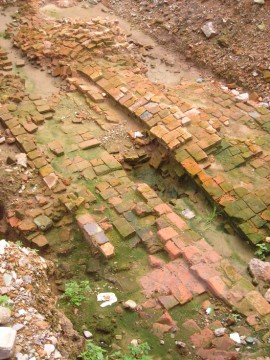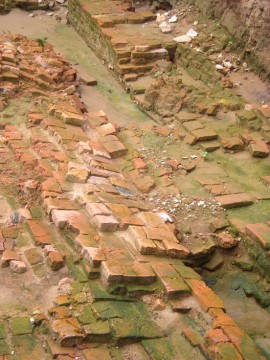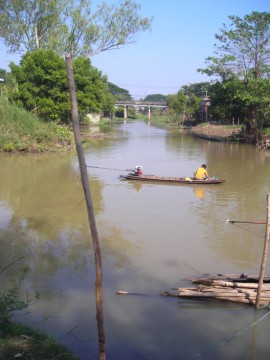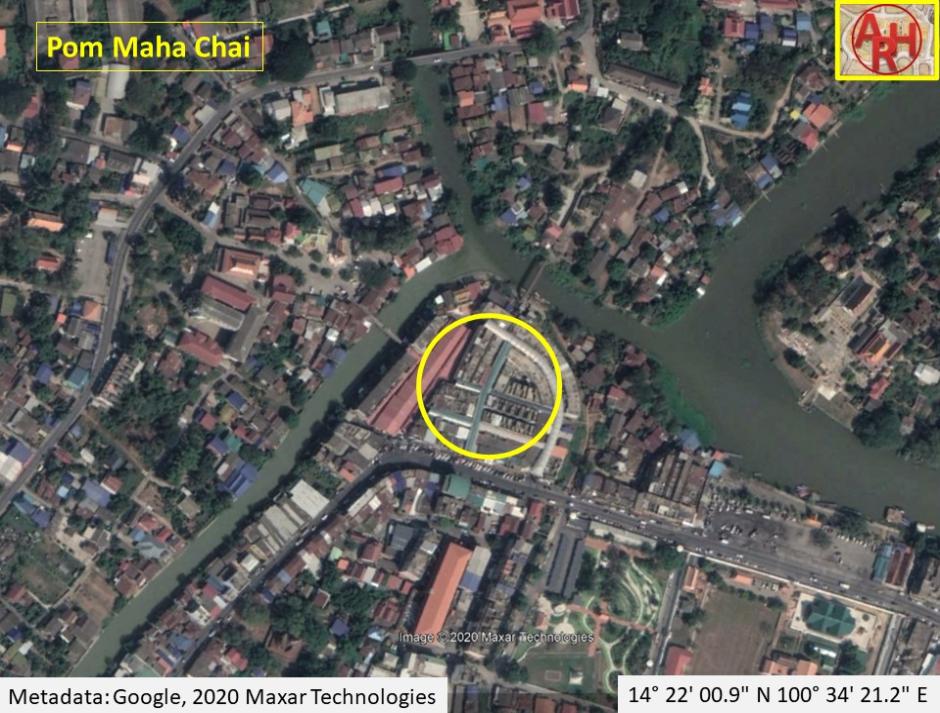| MAHA CHAI FORTRESS |

| Text & photographs by Ken May - January 2010 |
| Pom Maha Chai (Great Victory) was an important fortress located in the area where Hua Ro Market currently stands today. The remains of it were completely buried underground until 2009. While constructing a new convenience chain store, a portion of the fortress was accidentally dug up, causing a halt in the process. The area was excavated revealing a number of fortified walls and a great deal of broken ceramic pottery. It was eventually covered with soil once again, but a commemorative wall was erected at the site as a memorial. This can be seen beside U-thong Road near the market’s entrance. Despite the small size of the memorial wall, Pom Maha Chai played a vital role in Ayutthaya’s history. It was situated at a strategic point where the old Lopburi River (Khlong Bang Khuat) reached the main city island. This location gave Pom Maha Chai prime military importance and it was thus a site of major battles with the Burmese. After King Chakkraphat died in 1569, invading Burmese troops formed a tight siege ring around the city, digging trenches around the city moat. They also built a causeway across the old Lopburi River which connected the Phaniat peninsula to the city island near the Maha Chai Fortress. This causeway became known as Thamnop Ro, and the Burmese used it to launch further attacks. The Siamese troops under King Mahin made a powerful defensive stance at the Maha Chai Fortress, but eventually lost the war on August 8, 1569, and the city became a vassal state (Wyatt 82). The Burmese looted the city and led thousands away as war captives. Okya Phitsanulok was installed on the throne and given the title of King Maha Thammaracha. In 1580, King Maha Thammaracha launched enormous land development projects. Forced laborers dug a canal from the Maha Chai Fortress to the Phet Fortress (Pom Phet). Then the city walls were moved to the eastern bank of the city island (Cushman 82). The King renovated the Thamnop Ro causeway so that it was six meters wide and made of brick. It was then used for state purposes only. Elephant, horses, and wagons traveled from the city island to the Phaniat plain (Kasetsiri 328). This bridge features on a number of old European maps. Wat Maha Chai was also the location of a failed revolt. In 1696, Master Tham Thian pretended to be Lord Aphaithot, who was executed by King Petracha and Prince Sorasak at Wat Khok Phraya before he could inherit the throne. Tham Thian mounted a bull elephant and set out to falsely claim the throne. A group of about 500 paddy farmers were fooled into joining him in an armed confrontation. Tham Thian maneuvered his elephant towards the Thamnop Ro causeway in front of the Maha Chai fortress. At this point, he was identified as an imposter and shot down by Prince Sorasak while standing on top of the Maha Chai fortress. King Petracha had the followers flogged and beaten then forced them to build junks, enter prison, or cut elephant grass (Cushman 322-327). In a later and more finite invasion, this time in 1767, Burmese were able to set up a bridge in front of the Maha Chai Fortress. Burmese soldiers then raced across this bridge and dug tunnels to set the city walls on fire. As a result, the walls near Pom Maha Chai were greatly weakened and eventually collapsed. On April 7, 1767, Burmese breached the walls at Pom Maha Chai and ransacked the city. The ancient Ayutthaya kingdom was then destroyed, marking an end of the Siamese capital. After the Burmese were finally forced from Ayutthaya by King Taksin, the remains of Pom Maha Chai were (perhaps symbolically) transported to Bangkok by King Rama I to construct the new capital of Siam. King Rama III also removed a number of bricks from this area, including the Thamnop Ro causeway and Sapan Chang to built Wat Saket in Bangkok, which collapsed in the process of construction and ultimately became known as the Temple of the Golden Mount. The area where Pom Maha Chai once stood became a thriving market area known as the Hua Ro. With the signing of the Bowring treaty in 1855, the rice trade was opened so that Great Britain could supply its emerging colonies with rice. As a result, a large community of Chinese traders established themselves in the area, and some of these families still inhabit the market area even today. As an interesting side note, the exact location where the excavation took place bears its own unique history. It was the site where a risqué theater once stood that projected adult- oriented movies (tame by Western standards). Local expatriates still recall seeing rats running down the aisles. This theater was closed and destroyed sometime after 2002. Local Thais used this site as a makeshift badminton court in the years afterward. Many Thais still believe that this site is cursed due to its bad historical Karma. It is suggested that any business that opens on this site is doomed to fail. In the case of the convenience chain store, which construction was successful stopped, this prophesy has evidently proved correct. |



